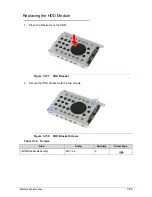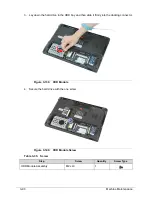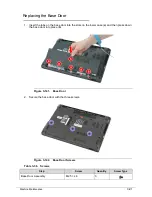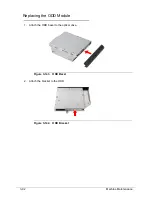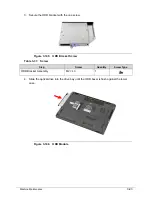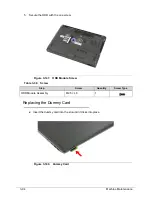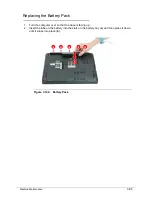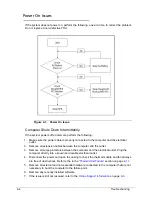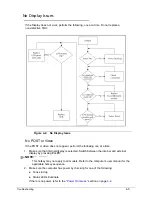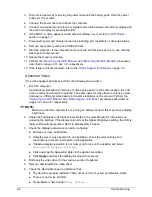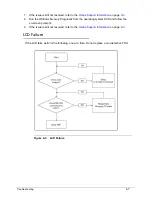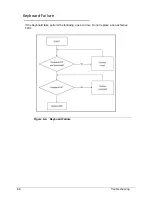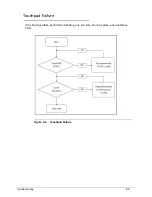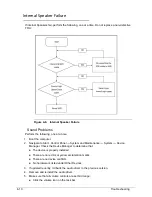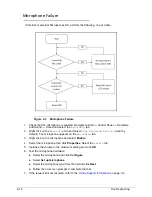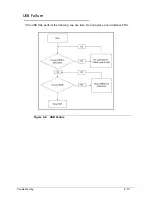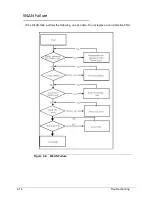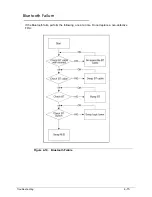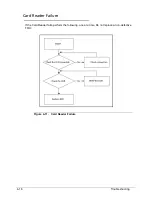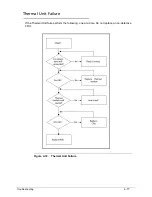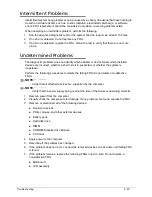
4-6
Troubleshooting
3. Drain stored power by removing the power cable and the battery pack. Hold the power
button for 10 seconds.
4. Connect the power cable and reboot the computer.
5. Connect an external monitor to the computer and switch between the internal display and
the external display by pressing
Fn
+
F5
.
6. If the POST or video appears on the external display only, refer to the “
LCD Failure”
section on page
4-7
.
7. Disconnect power and all external devices including port replicators or docking stations.
8. Remove any memory cards and CD/DVD discs.
9. Start the computer. If the computer boots correctly, add the devices one by one until the
failure point is discovered.
10. Reseat the memory modules.
11. Perform the “
Removing the HDD Module
” and “
Removing the ODD Module
” procedures
described on pages
3-14
and
3-11
respectively.
12. If the issue is still not resolved, refer to the
Online Support Information
on page
9-3
.
Abnormal Video
0
If the video appears abnormal, perform the following one at a time.
1. Boot the computer.
If permanent vertical/horizontal lines or dark spots appear in the same location, the LCD
panel is faulty and should be replaced. The same goes for when there is extensive pixel
damage (i.e. different colored spots in the same locations on the screen). Perform the
“
Removing the LCD Module
” and “
Removing the LCD Panel
” procedures described on
pages
3-41
and
3-47
respectively.
NOTE:
NOTE
:
Make sure that the computer is not running on battery alone as this may reduce display
brightness.
2. Adjust the brightness to its highest level. Refer to the User Manual for instructions on
adjusting the settings. If the display is too dim at the highest brightness setting, the LCD is
faulty and should be replaced. Refer to Disassembly Process.
3. Check the display resolution is correctly configured:
Minimize or close all Windows.
If display size is only abnormal in an application, check the view settings and
control/mouse wheel zoom feature in the application.
If desktop display resolution is not normal, right-click on the desktop and select
Personalize Display Settings
.
Click and drag the Resolution slider to the desired resolution.
Click
Apply
and check the display. Readjust if necessary.
4. Roll back the video driver to the previous version if updated.
5. Remove and reinstall the video driver.
6. Check the Device Manager to determine that:
The device is properly installed. There are no red Xs or yellow exclamation marks
There are no device conflicts
No hardware is listed under
Other Devices
Summary of Contents for Aspire 4560
Page 1: ... Aspire 4560 4560G SERVICEGUIDE ...
Page 10: ...x ...
Page 11: ...CHAPTER 1 Hardware Specifications ...
Page 14: ...1 4 ...
Page 51: ...CHAPTER 2 System Utilities ...
Page 67: ...CHAPTER 3 Machine Maintenance ...
Page 70: ...3 4 ...
Page 100: ...3 34 Machine Maintenance 4 Remove the USB board from the lower case Figure 3 44 USB Board ...
Page 109: ...Machine Maintenance 3 43 6 Remove the LCD module from the lower cover Figure 3 60 LCD Module ...
Page 162: ...3 96 Machine Maintenance ...
Page 163: ...CHAPTER 4 Troubleshooting ...
Page 193: ...CHAPTER 5 Jumper and Connector Locations ...
Page 200: ...5 8 Jumper and Connector Locations ...
Page 201: ...CHAPTER 6 FRU List ...
Page 202: ...6 2 Aspire 4560 4560G Exploded Diagram 6 4 Main Assembly 6 4 LCD Assembly 6 6 FRU List 6 7 ...
Page 217: ...CHAPTER 7 Model Definition and Configuration ...
Page 218: ...7 2 Aspire 4560 4560G 7 3 ...
Page 325: ...CHAPTER 8 Test Compatible Components ...
Page 326: ...8 2 Microsoft Windows 7 Environment Test 8 4 ...
Page 332: ...8 8 Test Compatible Components ...
Page 333: ...CHAPTER 9 Online Support Information ...
Page 334: ...9 2 Online Support Information 9 3 ...
Page 336: ...9 4 Online Support Information ...


